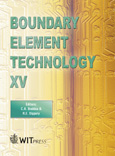Boundary Element Methods For Functionally Graded Materials
Price
Free (open access)
Transaction
Volume
34
Pages
10
Published
2003
Size
400 kb
Paper DOI
10.2495/BT030141
Copyright
WIT Press
Author(s)
G. H. Paulino, A. Sutradhar & L. J. Gruy
Abstract
Boundary element methods for functionally graded materials G.H. ~aulino', A. ~utradhar' & L.J. ~ r a ~ ~ I Department of Civil and Environmental Engineering, University of Illinois at Urbana-Champaign, USA. 2~omputer Science and Mathematics Division, Oak Ridge National Laboratory, USA. Abstract Functionally graded materials (FGMs) posscss a smooth variation of material properties due to gradual change in microstructural details. For example, the material gradation may change gradually from a pure ceramic to a pure metal. This work focuses on three-dimensional potential (both stcady state and transient) and clasticity problems for inhomogeneous materials. The Green's function (GF) for these materials (exponentially gradcd) are cxpressed as the GF for the hornogcneous material plus additional terms due to material gradation. The numerical implementations are performed using a Galerkin (rather than collocation) approximation. The results of test calculations are in good agreement with available
Keywords





